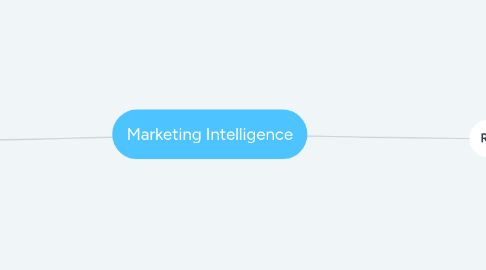
1. Concepts
1.1. ROI
1.1.1. Formula
1.1.1.1. Return/Investment
1.1.1.2. Incremental Sales / Investment
1.1.1.3. Incremental Brand Image / Investment
1.1.1.4. Awareness Points / Investment
1.1.2. Comparing (Relative to something)
1.1.2.1. [ [Sales in Units]/Investment ] / [Average Sales]
1.1.3. Ratios
1.1.3.1. $ / $
1.1.4. Units / $
1.2. Sales
1.2.1. Variables Affecting
1.2.1.1. Types
1.2.1.1.1. Marketing Variables (4Ps)
1.2.1.1.2. Brand Variables
1.2.1.1.3. Competitors Variables
1.2.1.1.4. Seasonal Variables
1.2.1.1.5. Exogenous Variables
1.2.2. How to measure variables's impact
1.2.2.1. Econometric Models
1.2.2.1.1. Multiple Linear Regression
1.2.2.1.2. Others
1.2.2.2. Before you start
1.2.2.2.1. Listen to the client
1.2.2.2.2. Make a graph
1.2.2.2.3. Think
1.2.2.3. Process
1.2.2.3.1. Process graph
1.2.2.4. Steps
1.2.2.4.1. 1. Make descriptive Analysis
1.2.2.4.2. 2. Modeling in order
1.2.2.4.3. 3. Validate the model, it is good when
1.2.2.4.4. 4. Calculate de ROI
2. Readings
2.1. 1. Commercial Effectiveness with Marketing Mix Modeling (MMM)
2.1.1. Benefits
2.1.1.1. More accurate attribution of ROIs
2.1.1.2. Better alignment with business planning processes
2.1.1.3. Increase sales, profits and shareholder value
2.1.1.3.1. Marketing Budget Growth
2.1.1.3.2. Revenue Growth
2.1.1.3.3. Share Growth
2.1.1.4. Ability to model at the Market-Segment Level enables analysis across multiple customer channels
2.1.1.4.1. Market penetration
2.1.1.4.2. Cost per acquisition
2.1.1.4.3. Average return
2.1.1.4.4. Average responsiveness
2.1.1.5. Guide management along the path of business transformation
2.1.1.6. Improving the speed-to-insight
2.1.1.7. Feedback loop for marketing processes
2.1.2. Key metrics and business questions to be answered by MMM
2.1.2.1. ROI for each channel and campaign
2.1.2.2. future impact of a change in the marketing strategy and budget
2.1.2.3. optimal spend and mix of marketing investments
2.1.2.4. balance between brand building vs. product marketing
2.1.2.5. optimize sales and profit by customer segment
2.1.2.6. optimal timing for marketing campaigns
2.1.2.7. consumer sentiment and customer satisfaction
2.1.2.8. impact of loyalty program
2.1.2.9. activities to drive customer behavior
2.1.2.10. marketing effectiveness by channel and geography
2.1.2.11. impact of paid, earned and owned media
2.1.2.12. external factors - macroeconomic, weather, competition, etc.
2.1.3. Key Ingredients
2.1.3.1. 1. Holistic, more accurate MMM
2.1.3.1.1. Measure the Impact of all business drivers
2.1.3.2. 2. Consumer segmentation
2.1.3.2.1. Create relevant segments for the business.
2.1.3.2.2. Identify high and low value segments.
2.1.3.2.3. Reveal their attitudes and sensitivity to the company's actions and external variables.
2.1.3.3. 3. Integration of digital attribution and customer data
2.1.3.3.1. 20-30% incremental revenue and profit driven by marketing.
2.1.3.4. 4. Speed to Insight
2.1.3.4.1. Enhancements in data automation, technology and modeling platforms have increased the speed of the decision making process, utilising components such as:
2.1.3.5. 5. Engage the C-Suite
2.1.3.5.1. Increasing the adoption of this, it increases implementation success of modeling solutions.
2.1.3.5.2. Can help to drive strategic and tactical pricing decisions
2.1.4. Improving Value Proposition through actionable insights
2.1.4.1. Collaborative session to identify important issues with key business stakeholders.
2.1.4.2. Powerful, real-time simulation and optimization (what if scenario).
2.1.4.2.1. Improving our Maketing performance
2.1.4.3. Historical Due To's
2.1.4.3.1. Understand the real impact of different variables
2.2. 2. Beyond Marketing Mix Modeling: increasing demand for more requirements
2.2.1. Causes of the increase in requirements:
2.2.1.1. More complex market ecosystem.
2.2.1.2. The improvements in technology.
2.2.1.3. It is necessary to make decisions:
2.2.1.3.1. Faster.
2.2.1.3.2. On more granular levels.
2.2.1.3.3. At a far greater scale.
2.2.2. New requirements
2.2.2.1. Deliver right information to make decisions at the right time.
2.2.2.2. Using right and agile technology.
2.2.3. Key factors in the new "post-MMM":
2.2.3.1. Partnerships with world-class data providers
2.2.3.1.1. To increase accuracy and generate better, faster predictions by leveraging early indicators.
2.2.3.1.2. Examples: Google, Nielsen, Experian, Facebook...
2.2.3.2. More granular models that help:
2.2.3.2.1. Scale analytics across many decision-makers.
2.2.3.2.2. Improve predictive precision.
2.2.3.2.3. Apply insights more quickly to marketing decisions.
2.2.3.3. Ability to deliver a bigger payload
2.2.3.3.1. Cloud-based technologies can produce complex calculations more quickly and accommodate multiple dimensions of complexity.
2.2.3.4. Ability to deal with uncertainty
2.2.3.4.1. And create competitive advantage from it.
2.2.3.5. Adopt and embed analytics beyond the marketing department.
2.2.3.5.1. Help the marketing team to share insights credibly with other business units
2.2.3.5.2. Moving from a backward-looking organization to a foward-looking one.

